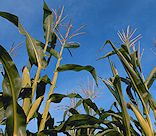
Uneven growth reports on Iowa corn proliferated during the early part of the 2009 growing season. As Iowa's 2009 corn crop is now transitioning into the reproductive growth stages, you should expect to see some variation within fields and among different corn hybrids as a result of various early-season stresses.
Regardless of the reason for uneven corn growth, uneven tasseling across the field can be seen in many cases this year. Iowa State University Extension corn agronomist Roger Elmore and soil fertility specialist John Sawyer offer the following observations and explanations of what's going on in farmers' fields.
What occurred earlier this season is affecting corn now
Numerous potential reasons exist for uneven growth and development. Unfortunately, emergence issues and uneven growth do not disappear entirely during the growing season. Although the difference among plants may lessen, uneven tassel emergence will result because of these problems. A review of articles posted in ISU's ICM newsletter discusses the early 2009 growing season and the types of stress encountered by the crop.
Early thunderstorms brought and strong winds destroying leaf area and killing plants. Recent thunderstorms in late June and early July resulted in green snap and root-lodged corn. Twisted whorls slowed development of some plants across the state. First generation corn borer activity was high, relative to the early 2000s, increasing variation within fields.
Because of cooler-than-normal temperatures and associated slower corn growth, postemergence herbicide applications negatively affected corn. Many farmers and crop consultants observed corn seedlings damaged from anhydrous ammonia - both fall and spring applied. Early-season weather conditions resulted in wide ranges in corn plant color - from green to yellow-green to purple and some with stripes.
Insect activity, wet soil at planting are other causes
Black cutworm activity and seedling disease iincidence seemed above normal. Armyworm outbreaks occurred in corn following cover crops with heavy residue. Intense weed competition occurred in some fields before postemergence herbicide applications. Some replanting occurred because of emergence variability. Soil surface crusting and sidewall compaction impeded plant emergence and growth in some fields. Shallow planting depth resulted in cases of rootless corn. Wet soils at planting and associated poor root and vegetative growth contributed to many of these problems.
In an apparent rerun of 2008, low areas flooded and problems associated with this included crazy top and nitrogen deficiency symptoms. In addition to all of this, wet weather delayed postemergence nitrogen applications resulting in attempts to apply nitrogen using various foliar fertilization methods.
In spite of all of these negative aspects of early corn growth, USDA's National Ag Statistics Service reported that as of July 6, based on the weekly statewide survey, 82% of Iowa's 2009 corn crop rated "good to excellent"—that's in stark contrast to the 57% rating during the same week in 2008. Last year's delayed planting in Iowa and historic flooding took their toll on the crop.
Most signs indicate Iowa's 2009 corn crop looks good! Only 4% was rated poor or very poor as of July 6–much better than the 13% last year in early July.
Summing up: As Iowa's 2009 corn crop hastens toward the pollination period in July, you should expect to see variation in tasseling and growth within and among some fields. This is directly resulting from one or more of the early-season stresses mentioned in this article. If severity of the stress factor was high resulting in significant variation in plant development, then you can expect a lower yield potential.
About the Author(s)
You May Also Like




